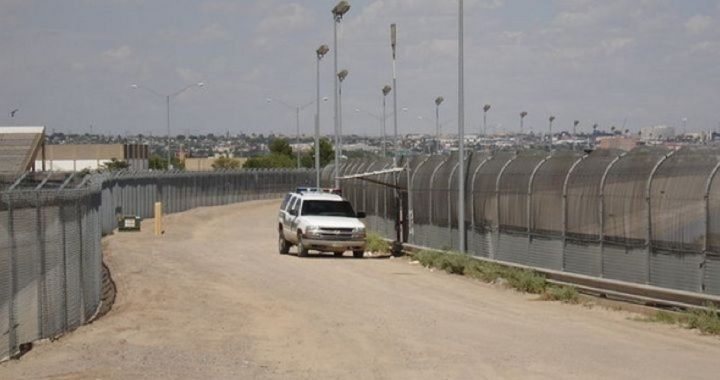
Perhaps no promise of then-candidate Donald Trump was more widely known. Once president, he would build a wall — a beautiful wall, at that, he said — and make the Republic of Mexico “pay for it.”
Of course, American voters like benefits paid for by someone else — especially foreigners. But what about the very real cost to U.S. citizens of a border wall? Constructing a wall all the way along the southern border would run head-on into the private property rights of Americans, especially in Texas.
As Congressman Ron Paul wrote recently of Trump’s ambitious goal, “He is right to focus on the issue,” but “there are several reasons why his proposed solution will unfortunately not lead us anywhere closer to solving the problem.”
“Texas already started building a border fence about ten years ago,” Paul explained. “It divided people from their own property across the border, it deprived people of their land through the use of eminent domain.” (Emphasis added.)
Eminent domain is the power of a government to take private land for public use. Unfortunately, some mistakenly believe the Constitution gave the U.S. government the “right” of eminent domain in the Fifth Amendment. On the contrary, unlike most governments in the world at that time, the Fifth Amendment restricted that power in two ways: (1) the taking must be for a public use; and (2) it can only be taken with just compensation.
In the early years of our Republic, roads, bridges, and the like were the major projects that justified taking the private property of an American citizen, because the public could make actual use of a road or a bridge. In recent years, however, governments have (like most things) stretched the powers beyond the envelope of the original intent of the Constitution’s framers, claiming “public use” includes any legitimate “public purpose.” As a result, there have been numerous instances where developers have persuaded their local governments to “condemn” someone’s property so it can be seized by the government. While the government pays “compensation” to the property owner, to be sure, it should be understood that if the developer had to pay the new fair market value (because some wealthy developer wants to obtain the property, so the value has now gone up, under a free market situation), he could not get it as cheaply as he could after the government has seized it. In other words, forcing a person to give up his property for less money than he wishes to receive in order to part with it — so it can be given to some developer cheaper than he otherwise would have been forced to pay — is essentially legalized theft.
Eminent domain would be necessary to build Trump’s wall because much of the land not presently walled, especially in south Texas, is in private hands. This is in contrast to the situation in some of the states west and northwest of Texas, which entered the Union at a time before the federal government opted to “keep” large portions of non-private land in those states. Texas, however, entered the Union in 1845 — in an era in which it was thought the states or its citizens should own the land, not the federal government.
While it is unlikely that the wall could be ultimately frustrated on the grounds that the federal government could not take private land under eminent domain, the fact that so much of the wall would have to be built on land owned by individuals creates many complications.
First, there is the philosophical objection: An American should not have to surrender part of his land, even if fairly compensated, if he doesn’t want to. As James Madison wrote, “Government is instituted to protect property of every sort; as well that which lies in the various rights of individuals, as that which the term particularly expresses. This being the end of government, that alone is a just government, which impartially secures to every man, whatever is his own.” (Emphasis in original.)
In the case of the Trump Wall, this would constitute government taking property, rather than protecting it.
Second, there are practical problems that must be considered. As Representative John Carter (R-Texas) explained, while he supports building a wall “where barriers will work,” in the case of southern Texas, it is sometimes not so simple. “I’ve been trying to preach — and I’ve kind of got the White House and the Justice Department and other people to realize — that Texas is a very peculiar state, a very blessed state…. All that land along the river, along the border down there is owned by people and corporations. It’s private property. If they’re building a wall in Texas, it means they are building on private land, which means it’s harder, a lot harder.”
For instance, the wall is obviously not going to be built right on the border itself. While the federal government may want to offer compensation just for the actual amount of property taken in order to build a border wall, what about the damage such a wall would cause to the property value of the land beyond the reach of the wall, that can no longer be accessed?
In some cases, the wall would snake through lands owned by various American Indian tribes, such as the Kickapoo. Taking land from Native Americans could turn into a public relations nightmare for the Trump administration, as it would naturally conjure up historical references to the federal government’s “land grabs” in the 19th century.
When Trump launched his candidacy in 2015, one of the issues that dogged him was his past use as a businessman of eminent domain in an attempt to seize land to expand his business enterprises. When some land owners balked at selling him their property to build a casino in Atlantic City, New Jersey, for instance, Trump turned to a government agency — the Casino Reinvestment Development Authority (CRDA) — to simply take the property under eminent domain. He argued that a parking lot for his casino would serve a better “public purpose” than what the property of the recalcitrant landowners was then being used for: private homes.
It was a public relations fiasco for Trump. A Russian immigrant, Peter Banin, had purchased another building on the block with his brother, paying $500,000 to open a pawn shop. CRDA offered them only $174,000 to vacate the property in favor of Trump’s project. Banin responded, “I knew they could do this in Russia, but not here. I would understand if they needed it for an airport runway, but for a casino?” Fortunately for Banin, Trump and the CRDA lost in court in the case — CRDA v. Banin.
If, however, Trump’s envisioned wall gets bogged down in protracted eminent domain lawsuits involving land along the border with Mexico, there is little doubt that these past uses of eminent domain when Trump was a developer will be dredged up in the fight to block the wall.
Gerald Dickinson, a law professor at the University of Pittsburgh, considered an expert in federal eminent domain law, stated, “It could potentially be the nail in the coffin because the problem that the Trump Administration is going to come across is the potential for public opinion backlash.”
Former Congressman Paul has also noted that while it is not Trump’s intention, a wall can serve to “keep people in” as well as to “keep people out.”
While a wall in some places along the international border might very well help in controlling illegal entry into the United States, electronic monitoring and well-placed Border Patrol agents would likely be a more practical alternative to several hundred miles of wall.
Another way to cut down on the problem of illegal immigration is to enforce present immigration laws, punishing businesses that can legally be proven to be hiring undocumented workers.
Paul argued that we should “remove the welfare magnet that attracts so many to cross the border illegally.… The various taxpayer-funded programs that benefit illegal immigrants in the United States, such as direct financial transfers, medical benefits, food assistance, and education, cost an estminated $100 billion dollars per year. That is a significant burden on citizens and legal residents. The promise of free money, free food, free education, and free medical care if you cross the border is a powerful incentive for people to do so. It especially makes no sense for the United States government to provide these services to those who are not in the U.S. legally.”
All of this taken together will greatly reduce the problem of illegal immigration. It is not necessary to stop such practices completely, however; once it becomes known that the United States is serious about securing its borders, illegal entry into this country would be reduced to an insignificant problem.



